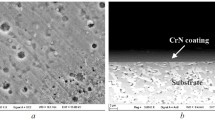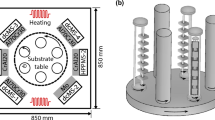Abstract
A good understanding of the coating wear mechanism is essential in relation to tailoring the coating properties to the application, with a focus on increasing the tool performance. When a coated cemented carbide tool is applied in processes with high thermal and mechanical loads (e.g., hard turning process), the cutting tool can suddenly collapse with the deterioration of the coating. The focus of this research was to track the sequence of events that leads to the deterioration of coating materials (PVD TiAlN and MT CVD TiCN/Al2O3/TiN), to reveal the real wear mechanisms associated with coated cemented carbide cutting tools applied to hard turning. The tool wear was evaluated by focus variation microscopy (FVM) and scanning electron microscopy (SEM), before and after cutting edge collapse, during the hard turning of quenched and tempered AISI 4340 steel. The mechanisms associated with the progression of wear on MT CVD coatings involve abrasion, crack nucleation, propagation, the formation of crack networks, delamination, detachment between coating layers, and spalling. The deterioration of PVD coatings is related to the abrasion wear mechanism and the high deformation values at the cutting edge, which leads to the nucleation of cracks in the coating, reducing the bonding strength between the coating and the tool substrate, leading to spalling of the coating. The tool life of the PVD coating was three times longer than that of the CVD coating. The wear mechanisms acting on the coating is the main factor that influences the end of tool life.









Similar content being viewed by others
References
Bobzin K (2017) High-performance coatings for cutting tools. CIRP J Manuf Sci Technol 18:1–9. https://doi.org/10.1016/j.cirpj.2016.11.004
García J, Collado Ciprés V, Blomqvist A, Kaplan B (2019) Cemented carbide microstructures: a review. Int J Refract Met Hard Mater 80:40–68. https://doi.org/10.1016/j.ijrmhm.2018.12.004
Bouzakis KD, Michailidis N, Skordaris G, Bouzakis E, Biermann D, M’Saoubi R (2012) Cutting with coated tools: coating technologies, characterization methods and performance optimization. CIRP Ann Manuf Technol 61:703–723. https://doi.org/10.1016/j.cirp.2012.05.006
Holmberg K, Mattheus A (2009) Coating tribology: properties, mechanisms, techniques and applications in surface engineering, 2nd edn. Elsevier, Amsterdam
Childs T, Maekawa K, Obikawa T, Yamane Y (2000) Metal machining theory and applications, 1st edn. Wiley, London
Tkadletz M, Schalk N, Daniel R, Keckes J, Czettl C, Mitterer C (2016) Advanced characterization methods for wear resistant hard coatings: a review on recent progress. Surf Coat Technol 285:31–46. https://doi.org/10.1016/j.surfcoat.2015.11.016
Sveen S, Andersson JM, M’Saoubi R, Olsson M (2013) Scratch adhesion characteristics of PVD TiAlN deposited on high speed steel, cemented carbide and PCBN substrates. Wear. 308:133–141. https://doi.org/10.1016/j.wear.2013.08.025
Bouzakis KD, Klocke F, Skordaris G, Bouzakis E, Gerardis S, Katirtzoglou G, Makrimallakis S (2011) Influence of dry micro-blasting grain quality on wear behaviour of TiAlN coated tools. Wear. 271:783–791. https://doi.org/10.1016/j.wear.2011.03.010
Fox-Rabinovich GS, Kovalev AI, Aguirre MH, Beake BD, Yamamoto K, Veldhuis SC, Endrino JL, Wainstein DL, Rashkovskiy AY (2009) Design and performance of AlTiN and TiAlCrN PVD coatings for machining of hard to cut materials. Surf Coat Technol 204:489–496. https://doi.org/10.1016/j.surfcoat.2009.08.021
Thakur A, Gangopadhyay S (2016) Influence of tribological properties on the performance of uncoated, CVD and PVD coated tools in machining of Incoloy 825. Tribol Int 102:198–212. https://doi.org/10.1016/j.triboint.2016.05.027
Ginting A, Skein R, Cuaca D, Herdianto, Pieter, Masyithah Z (2018) The characteristics of CVD- and PVD-coated carbide tools in hard turning of AISI 4340. Measurement 129:548–557. https://doi.org/10.1016/j.measurement.2018.07.072
Boing D, de Oliveira AJ, Schroeter RB (2018) Limiting conditions for application of PVD (TiAlN) and CVD (TiCN/Al2O3/TiN) coated cemented carbide grades in the turning of hardened steels. Wear. 416–417:54–61. https://doi.org/10.1016/j.wear.2018.10.007
Boing D, Schroeter RB, de Oliveira AJ (2018) Three-dimensional wear parameters and wear mechanisms in turning hardened steels with PCBN tools. Wear. 398–399:69–78. https://doi.org/10.1016/j.wear.2017.11.017
Vereschaka AA, Grigoriev SN (2017) Study of cracking mechanisms in multi-layered composite nano-structured coatings. Wear. 378–379:43–57. https://doi.org/10.1016/j.wear.2017.01.101
Trent EM, Wright PK (2000) Metal cutting, 4th edn. Butterworth–Heinemann, Woburn
Astakhov VP (2012) Tribology of metal cutting, 1st edn. Elsevier Science, Oxford
Sandvik Coromant (2010) Application guide: Heat resistant super alloys. 128. http://www.sandvik.coromant.com/SiteCollectionDocuments/downloads/global/technical guides/en-us/C-2920-034.pdf
Sandvik Coromant (2016) Steel turning endurance: new innovation delivers best practice solutions to daily machining challenges. 11. https://www.sandvik.coromant.com/SiteCollectionDocuments/campaigns/cutting-steel-inserts/assets/white-paper-eng.pdf
Vereschaka AA, Grigoriev SN, Sitnikov NN, Batako AD (2017) Delamination and longitudinal cracking in multi-layered composite nano-structured coatings and their influence on cutting tool life. Wear. 390–391:209–219. https://doi.org/10.1016/j.wear.2017.07.021
Diniz AE, de Oliveira AJ (2008) Hard turning of interrupted surfaces using CBN tools. J Mater Process Technol 195:275–281. https://doi.org/10.1016/j.jmatprotec.2007.05.022
Acknowledgments
The authors would like to thank Sandvik Coromant® for supplying the cutting tools, Alicona® for providing resources and discussions regarding the measurement methods, Third Wave Systems® for providing resources for the turning process finite element analysis, and Villares Metals® for supplying the steel alloys.
Funding
The authors would like to acknowledge financial support from FAPESC (Foundation for Research and Innovation Support of the Santa Catarina State – Brazil) within the research project “Machining of Hardened Steels – 2015TR304.”
Author information
Authors and Affiliations
Corresponding author
Additional information
Publisher’s note
Springer Nature remains neutral with regard to jurisdictional claims in published maps and institutional affiliations.
Rights and permissions
About this article
Cite this article
Boing, D., de Oliveira, A.J. & Schroeter, R.B. Evaluation of wear mechanisms of PVD and CVD coatings deposited on cemented carbide substrates applied to hard turning. Int J Adv Manuf Technol 106, 5441–5451 (2020). https://doi.org/10.1007/s00170-020-05000-x
Received:
Accepted:
Published:
Issue Date:
DOI: https://doi.org/10.1007/s00170-020-05000-x




